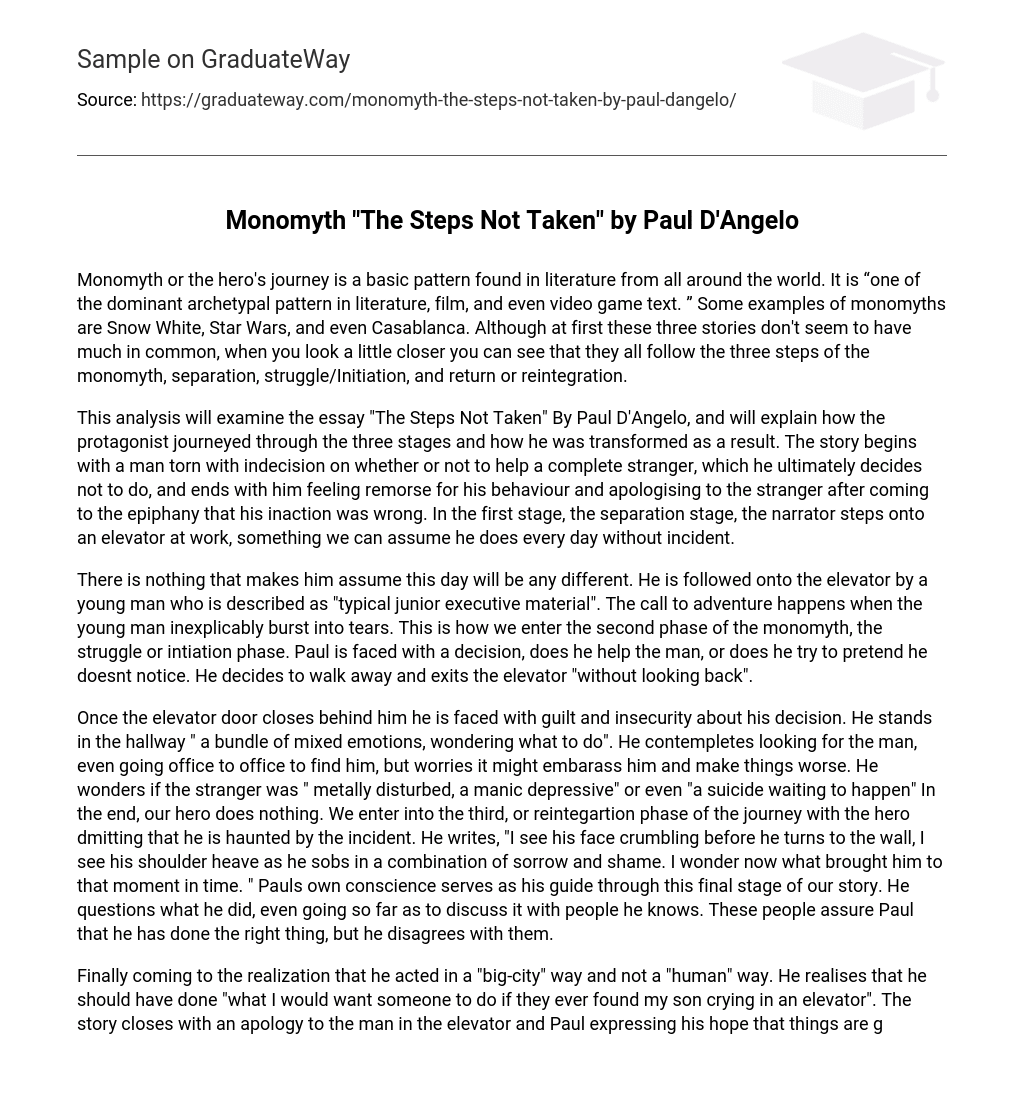Monomyth or the hero’s journey is a basic pattern found in literature from all around the world. It is “one of the dominant archetypal pattern in literature, film, and even video game text. ” Some examples of monomyths are Snow White, Star Wars, and even Casablanca. Although at first these three stories don’t seem to have much in common, when you look a little closer you can see that they all follow the three steps of the monomyth, separation, struggle/Initiation, and return or reintegration.
This analysis will examine the essay “The Steps Not Taken” By Paul D’Angelo, and will explain how the protagonist journeyed through the three stages and how he was transformed as a result. The story begins with a man torn with indecision on whether or not to help a complete stranger, which he ultimately decides not to do, and ends with him feeling remorse for his behaviour and apologising to the stranger after coming to the epiphany that his inaction was wrong. In the first stage, the separation stage, the narrator steps onto an elevator at work, something we can assume he does every day without incident.
There is nothing that makes him assume this day will be any different. He is followed onto the elevator by a young man who is described as “typical junior executive material”. The call to adventure happens when the young man inexplicably burst into tears. This is how we enter the second phase of the monomyth, the struggle or intiation phase. Paul is faced with a decision, does he help the man, or does he try to pretend he doesnt notice. He decides to walk away and exits the elevator “without looking back”.
Once the elevator door closes behind him he is faced with guilt and insecurity about his decision. He stands in the hallway ” a bundle of mixed emotions, wondering what to do”. He contempletes looking for the man, even going office to office to find him, but worries it might embarass him and make things worse. He wonders if the stranger was ” metally disturbed, a manic depressive” or even “a suicide waiting to happen” In the end, our hero does nothing. We enter into the third, or reintegartion phase of the journey with the hero dmitting that he is haunted by the incident. He writes, “I see his face crumbling before he turns to the wall, I see his shoulder heave as he sobs in a combination of sorrow and shame. I wonder now what brought him to that moment in time. ” Pauls own conscience serves as his guide through this final stage of our story. He questions what he did, even going so far as to discuss it with people he knows. These people assure Paul that he has done the right thing, but he disagrees with them.
Finally coming to the realization that he acted in a “big-city” way and not a “human” way. He realises that he should have done “what I would want someone to do if they ever found my son crying in an elevator”. The story closes with an apology to the man in the elevator and Paul expressing his hope that things are getting better for him, that “his sorrow is a thing of the past” and that ” he is never again burdened with such awful despair. ” In his apology Paul admits that he was wrong to not come to the mans aid. This is his epiphany.
He will never again allow insecurity and doubt to stop him from helping a person in need. He learned that the “big city” way of detaching himself from his fellow man does not protect him, it just makes him unable to connect with people even in a desperate situation. This detachment is something we’re all guilty of, and we can all benefit from his lesson. The world is full of strangers and sometimes we need to look outside of the protective bubbles we create for ourselves, whether its for our own good or someone elses.





